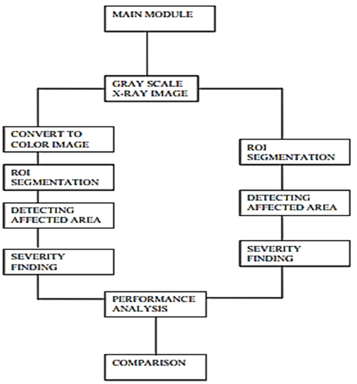Machine Learning for Early Detection of Pneumonia from Chest X-ray Images
Keywords:
Machine Learning, Deep Learning, CNN, Transfer Learning, Chest X-Ray ImagesAbstract
Infectious agents such as bacteria, viruses, and fungi may all lead to a lung infection known as pneumonia. Particularly at risk are the elderly and those with weak immune systems, but anybody may fall victim to this potentially fatal sickness. Several investigations have used deep learning and machine learning strategies to identify pneumonia in chest X-rays and CT scans. Using these methods, a model is trained on a huge collection of labelled photos so that it can recognise characteristics and patterns characteristic of pneumonia. In 2017, for instance, the journal Radiology included a research that employed deep learning to diagnose pneumonia. With an AUC (area under the curve) of 0.97, this study's authors reported that a convolutional neural network (CNN) trained on a dataset of chest X-rays could effectively categorise pictures as normal or pneumonia. Another research that employed a machine learning technique to diagnose pneumonia from chest X-rays was published in 2018 in the journal Chest. Researchers discovered that their model had an AUC of 0.94 and an 89.6 percent success rate. The application of deep learning and machine learning to diagnose pneumonia has shown encouraging results so far, and it has the potential to improve diagnostic precision and productivity.
Downloads
References
T. Ouleddroun, A. Ellahyani and M. El Ansari, "Automated Pneumonia Detection using deep features in chest X-ray images," 2023 3rd International Conference on Intelligent Communication and Computational Techniques (ICCT), Jaipur, India, 2023, pp. 1-6, doi: 10.1109/ICCT56969.2023.10076157.
M. S. Munna and Q. Delwar Hossain, "An Automatic Detection of Pneumonia from Chest Ionizing Radiation Images Using Machine Learning Algorithm," 2022 4th International Conference on Sustainable Technologies for Industry 4.0 (STI), Dhaka, Bangladesh, 2022, pp. 1-5, doi: 10.1109/STI56238.2022.10103279.
S. Parveen and K. B. Khan, "Detection and classification of pneumonia in chest X-ray images by supervised learning," 2020 IEEE 23rd International Multitopic Conference (INMIC), Bahawalpur, Pakistan, 2020, pp. 1-5, doi: 10.1109/INMIC50486.2020.9318118.
R. E. Al Mamlook, S. Chen and H. F. Bzizi, "Investigation of the performance of Machine Learning Classifiers for Pneumonia Detection in Chest X-ray Images," 2020 IEEE International Conference on Electro Information Technology (EIT), Chicago, IL, USA, 2020, pp. 098-104, doi: 10.1109/EIT48999.2020.9208232.
]Li Q, Zhang L, Chen M, et al. Automated detection of pneumonia in chest X-ray images using a deep learning model. Radiology, 291(3): 673-681, 2019.
DS Kermany, M Goldbaum and W. Cai, "Identifying medical diag-noses and treatable diseases by image-based deep learning", Cell, vol. 172, no. 5, pp. 1122-31, 2018.
A. Torres, C. Cilloniz, M.S. Niederman et al., "Pneumonia", Nat Rev Dis Primers, vol. 7, no. 25, 2021.
Rana, P. ., Sharma, V. ., & Kumar Gupta, P. . (2023). Lung Disease Classification using Dense Alex Net Framework with Contrast Normalisation and Five-Fold Geometric Transformation. International Journal on Recent and Innovation Trends in Computing and Communication, 11(2), 94–105. https://doi.org/10.17762/ijritcc.v11i2.6133
T Assfaw, C Yenew, K Alemu, W Sisay and T. Geletaw, "Time-to-Recovery from Severe Pneumonia and Its Determinants Among Chil-dren Under-Five Admitted to University of Gondar Comprehensive Specialized Hospital in Ethiopia: A Retrospective Follow-Up Study", Pediatric Health Med Ther, vol. 12:189-196, pp. 2015-2020, Apr 2021
N. Habib, M.M. Hasan, M.M. Reza et al., "Ensemble of CheXNet and VGG-19 Feature Extractor with Random Forest Classifier for Pediatric Pneumonia Detection", SN COMPUT. SCI., vol. 1, no. 359, 2020.
V. Sirish Kaushik, Anand Nayyar, Gaurav Kataria and Rachna Jain, "Pneumonia Detection Using Convolutional Neural Networks (CNNs)", Proceedings of First International Conference on Computing Communications and Cyber-Security (IC4S 2019).
K. Akila, L. S. Jayashree and A. Vasuki, "Mammographic image enhance-ment using indirect contrast enhancement techniques- a comparative study", Procedia Comput. Sci., vol. 47, pp. 255-261, 2015.
Dhabliya, M. D. . (2021). Cloud Computing Security Optimization via Algorithm Implementation. International Journal of New Practices in Management and Engineering, 10(01), 22–24. https://doi.org/10.17762/ijnpme.v10i01.99
W. G. Flores and W. C. de Albuquerque Pereira, "A contrast enhancement method for improving the segmentation of breast lesions on ultrasonog-raphy", Comput. Biol. Med., vol. 80, pp. 14-23, 2017.
Y. M. George, B. M. Bagoury, H. H. Zayed and M. I. Roushdy, "Automated cell nuclei segmentation for breast fine needle aspiration cytology", Signal Proc., vol. 93, no. 10, pp. 2804-2816, 2013.
E. A. Murillo-Bracamontes, M. E. Martinez-Rosas, M. M. Miranda-Velasco, H. L. Martinez-Reyes, J. R. Martinez-Sandoval and H. Cervantes-de-Avila, "Implementation of Hough transform for fruit image segmen-tation. Procedia Eng", International Meeting of Electrical Engineering Research 2012, vol. 35, pp. 230-239, 2012.
L. Unzueta, M. Nieto, A. Cortes, J. Barandiaran, O. Otaegui and P. Sanchez, "Adaptive multicue background subtraction for robust vehicle counting and classification", IEEE Trans. Intell. Transp. Syst., vol. 13, no. 2, pp. 527-540, 2012.

Downloads
Published
How to Cite
Issue
Section
License

This work is licensed under a Creative Commons Attribution-ShareAlike 4.0 International License.
All papers should be submitted electronically. All submitted manuscripts must be original work that is not under submission at another journal or under consideration for publication in another form, such as a monograph or chapter of a book. Authors of submitted papers are obligated not to submit their paper for publication elsewhere until an editorial decision is rendered on their submission. Further, authors of accepted papers are prohibited from publishing the results in other publications that appear before the paper is published in the Journal unless they receive approval for doing so from the Editor-In-Chief.
IJISAE open access articles are licensed under a Creative Commons Attribution-ShareAlike 4.0 International License. This license lets the audience to give appropriate credit, provide a link to the license, and indicate if changes were made and if they remix, transform, or build upon the material, they must distribute contributions under the same license as the original.





